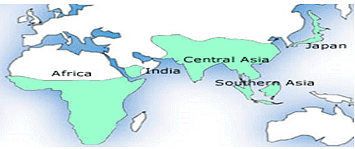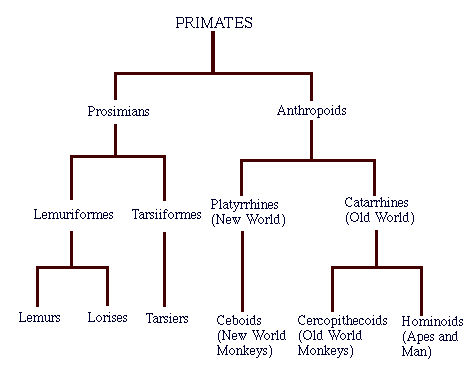Characteristics of Primates | Anthropology Optional for UPSC PDF Download
INTRODUCTION: Primates Characteristics
A diverse group of animals represented by animals such as humans, monkeys, prosimians and
apes is known as Primates.
Some Common Characteristics of Primates
- Dexterous hands
- A generalized skeleton for great physical agility
- Large brain size
- keen vision.
- Mostly Smaller offspring than other animals, who require more attention in their rearing.
Habitats
- Primarily in the tropical and subtropical regions of the New and Old Worlds.
- Never lived in Australia and most of the islands in the Pacific Ocean.
- Though there are evidences that around 55-50 million years ago the earliest primates also lived in North America and Europe.
Old World Monkey
- A group of primates which belong to the super family Cercopithecoidea.
- Native to Africa and Asia.
- Inhabiting a range of environments from tropical rain forest to savanna shrub land and mountainous terrain
- Cercopithecinae is mainly African species.
- Colobinae the second subfamily includes Asian genera and African colobus monkeys.

New World Monkey
- Found in Central and South America.
- Divided into four subfamilies of primates i.e.
- A) Cebidae, B) Aotidae, C) Pitheciidae D)Atelidae.
- Different noses on New World Monkeys are the most commonly used feature to distinguish from Old World Monkeys.
CLASSIFICATION OF PRIMATE

- Primates are divided into two sub-orders ie. lower primates or Prosimii and the higher primates or Anthropoidea.
- This division is mainly based on the brain size of both the orders.
- Brains sizes of lower primates have similar size to other mammals while higher primates have large brain size relative to body size.
Order primate of class Mammalia includes various types of animals. At the one end it has prosimian which may be small as squirrels and on the other hand, has large sized animals such as Man and Gorilla. At both the ends of primate there is lot of difference in terms of structure, behaviours , and intelligence. Such a large difference is not found in members of any other order. But still on basis of many similarities keeping all members of order primates in a single group seems logical, yet it is very difficult to define this order because of many differences.
Usually anthropologists avoid defining primates because of obvious problems related to the order. Of the two important definitions given for this order, the first was given by Mivert about
Years ago, according to which
- Placental mammals
- Unguiculate (possessing nails or claws, as opposed to hooves)
- Clavicles (collar bones) present
- Orbits encircled by bone
- Three types of teeth, at least at one time of life
- Brain always with a posterior lobe and calcarine fissure
- Innermost digit of at least one pair of extremities opposable
- Hallux (big toe) with a flat nail or none
- A well-developed caecum (appendix)
- Penis pendulous
- Testes scrotal
- Two pectoral mammae
After careful study of the definition it becomes clear that these are serial listing of characters of Primates and these are mixtures of two types of characters
1. General Mammalian Characters: Like three types of teeth, inceasers, canine and molars, testes in sac etc. are found in all mammals including primates and are equally developed in all primates.
2. Specialized characters of Primates: Like posterior lobe of brain and opposability of thumb etc. are found only in Primates and these are evolved in different levels i.e. suborder, genera, species etc. All these characters are found in Man too, hence we include man in order Primate.
Order Primate has been classified into two suborders i.e. Prosomii and Antropodia. Prosimii are further divided in to four infra orders i.e.
a. Tupaiiformes
b. Lemurifomes
c. Lorisiformes
d. Tarsiformes
Primates like Tupaia, Lemur, Loris and Tarsius are its members. Prosomii are called lower
primates and anthropoids are called higher primates.
Characters of Prosimii
a. For locomotion in are boreal life, usually two types of adaptation is found.
1. Tarsius having long legs for holding branches and for jumping from one branch to another and muscles developed in compact.
2. For slow quaderplasim, lemurs have short forelimbs and limbs are of same size, mobile pelvis and talus for swinging, tail small or absent.
b. Lack of separate mobility of fingers, use of all of them possible, precision grip impossible, to increase the hold, grip digits of figures with pads (feature of Men)
c. Claw in place of nail, usually on second and third finger for cleansing of the body
d. In comparison to anthropoids laterally placed eyes, eye balls not completely surrounded by bones.
e. For better hearing long and mobile ears.
f. Developed olfaction and organs associated with it.
g. In maxilla incisors are small and canines larger, in many species lower incisors and canines together efficient in cleaning the body. Dental formula usually 2:1:3:3
h. Foramen Magnum comparatively backward placed
i. Cerebrum small in size and lacking in complexity.
j. Digital formula usually IV>III>V>II>I
k. All animals arboreal usually nocturnal
Many characters of lower primates resembles more than other mammals than higher primates. Specialized characters of primates are not much developed in Prosomii, whereas in case of anthropoids the situation is just reversed. For example opposability of thumbs is found in all anthropoids whereas in Prosomii such possibility is marginally present. Similarly in prosimii second and third finger digit has claw instead of nail. Specialized / evolved characters of primates are seen in men that is why man is higher primate. Otherwise characters typical of Prosomii are not found in men. That is why men cannot be considered a member of this suborder.
Present day Prosomii are descendants of a 45 million years old large and mixed group, from which evolutionary of Anthropoids separated about 35 million years ago.
Characteristics of Anthropoids
Members of suborder Anthropoid have been kept into three super families i.e. Ceboidea, Cercopithecoidea and Hominoidea. All these from evolutionary point of view are major evolved than Prosomii, their brain is more complex, absence of wet mucus in the nostrils, and opposable thumb and possibility of bipedal locomotion etc. are more.
Characteristics of Anthropoid are as follows
1. Large and comparative round cranium.
2. Reduction in prognathism and size of nasal cavity, Face showing sign of coming right under frontal lobe of brain.
3. For front vision eyes are placed nearer to each other.
4. Facial muscles developed.
5. Fingers of foot and hand with nails, third finger longer than the fourth or same as fourth.
6. Pinna small and movable
7. Lachrymal canal opens into orbital cavity
8. Greater capacity for bipadelasim
9. Hands prehensile.
Many anthropologists classify anthropoids into two natural groups i.e. Platyrrhini and Catarrhini. Platyrrhini, on the basis of their geographical distribution are known as New World Monkeys and Catarrhini are known as Old World Monkeys which include Cercopithecoidea and Hominoidea. Though both of them have all the characteristics of the Anthropoids but Platyrrhini on the basis of the following characteristics can be separated from Catarrhini.
Characteristics of Platyrrhini
1. Brain more developed and complexed than Prosomii but less than Hominoids.
2. Dental formula 2,1,3,3 or 2,1,3,2
3. Molars and pre molars usually squarish
4. Zygomatic-Temporal fossa is bigger
5. Lack of buccal pouch
6. Lack of ischia callosities
7. Thumb not opposable and usually small or absent
8. Long big toe, more strong and distantly placed from fingers
9. Long and prehensile tail
Hominoidea
From anthropological point of view Hominoidea is most interesting group of the living primate world. Members of this group are considered as most intelligent among the entire animal kingdom.
Among its three families two, Hylobatidae and Pongidae are ape families and third is a Hominidae that is the family of man. Gibbon belongs to the family of Hylobatidae and Chimpanzee, Gorilla and Orangutan are members of the family Pongidae.
Among fossil hominoids Dryopithecus, Ramapithecus and Gigantopithecus are pongids whereas Australopithecus, Homo Erectus and Neanderthal man are included in family Hominidae. Usually Gibbon is called lower ape and chimpanzee and Gorilla are called higher apes. Among Hominoids, chimpanzee and gorilla are found in Africa whereas Orang and Gibbon is found in some parts of Asia.
Characters of Hominoidea
1. Increase in size but characteristics decrease in size of facial bones.
2. Change in dental arch from V shape to U shape.
3. Molars showing signs of increase in size
4. Lower third molar having characteristic Dryopithecus Y-5 cusp pattern.
5. Foramen magnum and occipital condyle showing signs of forward movement.
6. Neck and forelimbs are long
7. Broad shoulders and iliac bone.
8. More developed use of forelimbs. Hind limbs are comparatively less developed.
9. Lack of externally visible tail
Besides the characters of Hominoidea listed, higher apes and man have many interesting similarities. Both have similar blood proteins. Both live in small groups and both are prone to diseases like flu and syphilis. So can man be considered similar to apes? No because both of them have significant differences, important of these are listed here.
1. In comparison to apes knuckle walking, quadrupedalism and pronograde posture, man is bipedal and orthograde.
2. Hallux / great toe more developed and not opposable
3. Foot with curves to distribute body weight
4. Foramen magnum and occipital condyle placed lower and forward (sign of bipedalism)
5. Stereoscopic vision
6. Well-developed mastoid process.
7. Reduction in length of face and mandible, orthognathous or slight prognathous face.
|
108 videos|273 docs
|
FAQs on Characteristics of Primates - Anthropology Optional for UPSC
| 1. What are the characteristics of primates? |  |
| 2. How many different species of primates are there? |  |
| 3. What is the significance of opposable thumbs in primates? |  |
| 4. How do primates communicate? |  |
| 5. Are humans considered primates? |  |






















